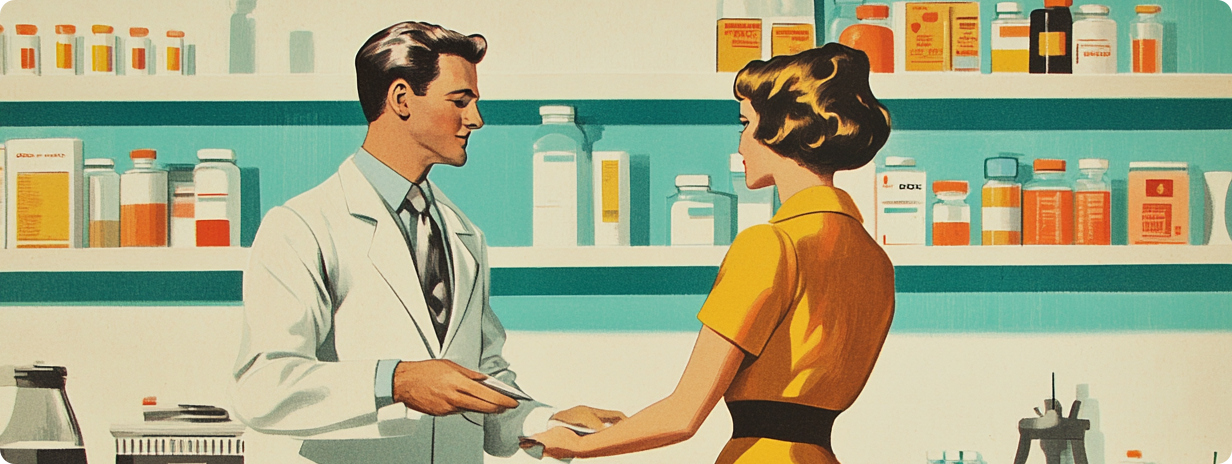“Direct to consumer” has always been a bit of a misnomer in pharma. Yes, ads for medicines of all kinds have been beamed directly into the living rooms and onto the devices of U.S. consumers since the airing of the first TV spot—for Rufen, an anti-inflammatory marketed by Boots Pharmaceuticals—on May 19, 1983. But unlike cars or phones or beer, prescription medications can’t be snapped up at the corner store. The need for a physician intermediary has always belied the “direct” part of DTC.
Which may be why the industry hasn’t quite figured out how to adjust its marketing to accommodate the demands of genuine direct-to-consumer engagement. In the pandemic’s long wake, industry mainstays (Eli Lilly, Novo Nordisk) and telehealth upstarts (Hims & Hers, Ro) have upended traditional marketing models, directly appealing to consumers in a way that would have been deemed revolutionary only a short time ago.
The trend took hold when Lilly and Novo rolled out LillyDirect and NovoCare, respectively, to capitalize on consumer demand for no-red-tape access to GLP-1 drugs Zepbound, Ozempic and Wegovy. Hims & Hers and Ro, meanwhile, exploited regulatory grey areas by selling compounded GLP-1s when the branded versions were in short supply, though the Food and Drug Administration pushed back on the tactic earlier this year.
“What once felt like an experimental fringe is now maturing into a legitimate engagement strategy,” says AstraZeneca director, omnichannel strategy Will McMahon.
GLP-1s may have accelerated the shift toward new direct-to-consumer approaches, but they weren’t the only products that captured the imagination of empowered health consumers. Concierge medicine, at-home testing, medical spas and weight-loss centers have all surged in popularity during the last half-decade, and all without the type of institutional marketing support that has long fueled the selling of health products and services.
The changes have been accompanied by an almost philosophical shift among A-list marketers. “‘Omnichannel’ as a term is going away—it makes more sense to think of everything in terms of a unified customer experience,” explains Stacy Stone, executive director, omnichannel and customer engagement, at Pacira BioSciences. “All these options make it possible to create the more personalized experience that consumers, patients and physicians get in banking and retail and everywhere else.”
But as the number of direct-to-consumer options continues to multiply, many organizations have been caught flat-footed by the pace of change. It’s very much an open question whether traditional industry players have accepted the new DTC reality, or even acknowledged it.
Witness the life sciences business’ pearls-clutching response to the rise of Hims & Hers and Ro. Barbara Salami, VP and U.S. head, commercial excellence and innovation, at Novo Nordisk, believes the industry has been “shaken to its core” by the emergence of these and similar organizations—and, in particular, their eager embrace by consumers frustrated with the status quo.
“They showcase an experience-first approach that resonates deeply with patients,” Salami explains. “They’re not just offering medications. They are crafting holistic experiences that prioritize patient needs and preferences.”
That the charge now includes pharma mainstays like Lilly, Novo and Pfizer adds to the sense of cognitive dissonance experienced by many established players. “It signifies a critical moment for the industry,” Salami adds.
But are those organizations prepared to confront the new reality, or will they retreat into their usual “we’re going to keep doing it this way, because this is the way we’ve always done it” shell?
“They talk a big game about transformation and adaptation without executing the deliberate, strategic shifts necessary to genuinely meet patients where they want to be,” Salami says.
Asked whether the life sciences business writ large is ready to accommodate those evolving and elevated expectations, Stone responds, “The attitude is that, as an industry, we do want to get there. But when it comes to medicine specifically, certain therapeutic areas are more ahead in their thinking than others. Oncology is probably the furthest down the road.”
To be sure, some skepticism remains. “These market moments are having a clear impact. But at the end of the day, the reality is that research and anecdotal evidence still suggest the reliance on patients depending on HCPs for accurate information is at an all-time high,” notes Madrigal Pharmaceuticals director, US marketing (NASH) Faizan Farukh.
There’s also increasing concern about patient education gaps, resistance from traditional prescribers and growing scrutiny around data privacy and informed consent. But even those who believe current trends have been overstated think that many of the changes are here to stay.
“Consumer expectations, from how they access and pay for medications to the resources and support that pharmaceutical manufacturers provide beyond the prescription, have shifted significantly as people become more informed, and more empowered, than ever,” says Derrick Gastineau, head of marketing at Currax Pharmaceuticals.
That’s why he believes the new direct-to-consumer reality offers plenty of upside. “The good news is consumers will readily convey their needs and expectations, if we are paying attention,” he continues. “As marketers we must listen to the voice of the customer and be prepared with dynamic, flexible solutions that can quickly address evolving expectations.”
Look for the industry to address those expectations proactively. Amit Akhelikar, chief operating officer and managing partner at Lynx Analytics, points to AIO (AI search optimization) as a tool that will factor heavily into the next wave of direct-to-consumer marketing.
“Are we seeing the death of SEO for younger patients and physicians? Are we focused on this today?,” he asks. “How ChatGPT and Google’s AI overview/Gemini aggregate information for a user is super-important for us to understand and create content around, so that the relevant information can be picked up.”
Questions around specific tactics notwithstanding, most execs sense a genuine willingness among their peers to abandon the traditional pharma playbook in favor of approaches better suited to the new era of direct-to-consumer appeals. Salami, a self-described optimist, believes industry marketers are up to the task.
“If they can pivot from awareness-building to an emphasis on customer experience, the potential is immense,” she says. “Companies that align themselves with the true needs of patients won’t just enhance brand loyalty, but also drive better health outcomes and satisfaction—and 10x business growth… The path forward is not merely a choice; it’s an imperative”
McMahon agrees. “The broader innovation playbook remains relevant. It’s going to be fascinating to see how these organizations pivot in the face of changing regulatory, supply chain and access dynamics.”
How has your organization adjusted, if at all, to accommodate the DTC 2.0 era? Drop us a note at hello@kinara.co, join the conversation on X (@KinaraBio) and subscribe on the website to receive Kinara content.



